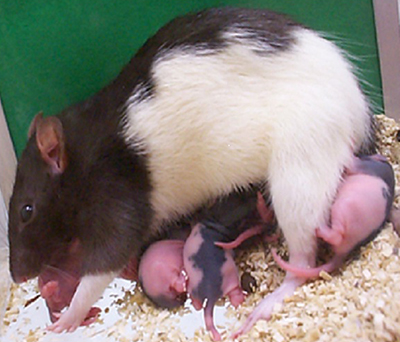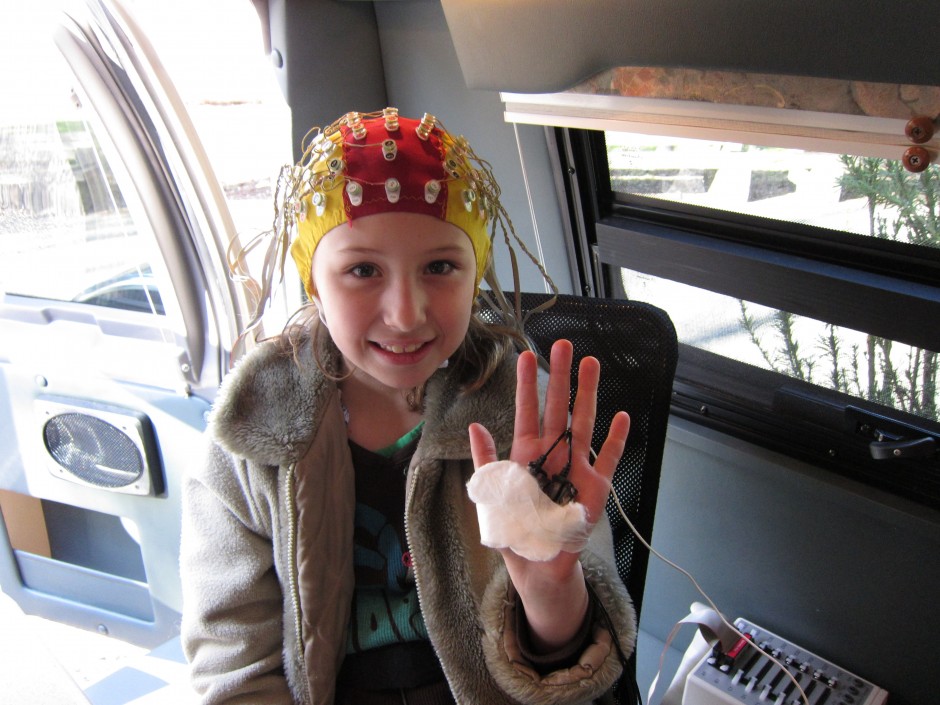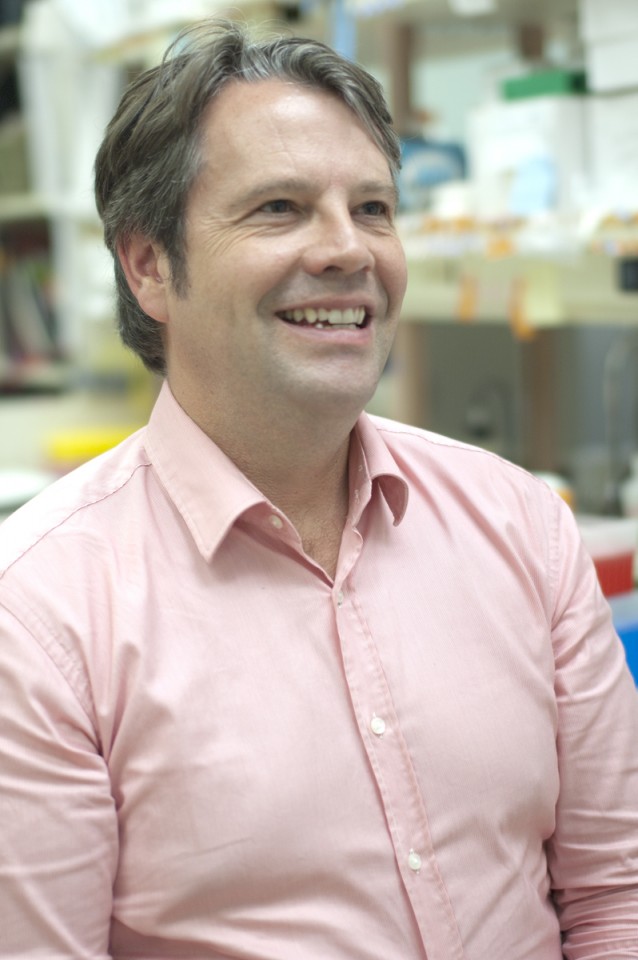By now, the experiment is a familiar reference point – perhaps the reference point – for the study of epigenetics, the science of gene expression.
Like many experiments, it involved rats. But this one seemed to resonate with humans in a way that few others do.

A mother rat arches her back to make it easier for her pups to nurse — a behaviour that dials down the pups’ response to stress. Photo courtesy of Michael Meaney
In brief: it compared the pups of nurturing mothers – those who made their milk readily available, and spent a lot of time licking their progeny – with the pups of those who were less attentive to their young. The pups of the less attentive mothers were more vulnerable to stress, and this difference corresponded to chemical tags on certain genes.
The findings electrified a whole segment of developmental scientists by demonstrating how environmental conditions can affect gene expression, and thus alter the trajectory of cells and whole organisms. In other words, it showed how life circumstances can get “under the skin,” affecting behaviour through biological mechanisms.
But the implications for human development remain almost as murky as ever, impeded by the hard requirements for scientific validation: large sample sizes, to establish correlations with statistical confidence, and long timeframes, to allow environmental conditions to make their mark.
Michael Kobor, however, is not the least bit intimidated.
“Whenever there is a challenge, I look at it as an opportunity,” says Dr. Kobor, an Associate Professor of Medical Genetics and a Senior Scientist of the Centre for Molecular Medicine and Therapeutics (CMMT). “We’re off to the races.”
The search for genetic dimmer switches
Dr. Kobor, a native of the Black Forest region of Germany, concedes he is predisposed to optimism – whether it’s a genetic inheritance, or something he developed through experience, is hard to say. But he has good reason to be confident.
For one, he has teamed up with McGill University Professor Michael Meaney, the scientist who designed those rat experiments.
Secondly, they have gained access to data about hundreds of children from around the world, including information about their upbringing and DNA-rich blood samples.
And they have secured a $1.5 million grant from the Brain Canada Foundation to make sense of it all.
Their project will be the first genome-wide examination of how childhood experience affects the human brain. Their focus is methylation, the bonding of a molecule made up of carbon and hydrogen to parts of the DNA. These compounds act as “dimmer switches” on genes, and thus play an enormous role in determining how cells behave. Whether methylation occurs, and where on the DNA it takes place, is now believed to be heavily influenced by environmental conditions.
In essence, Dr. Kobor and his collaborators are seeking the biological nexus, or nexuses, between nature (genes) and nurture (upbringing): whether certain adverse experiences, such as abuse, poverty or loneliness, leave lasting marks on the biology of the brain that lead to such maladies as depression, aggression or addiction.
“There is a huge amount of very diverse but very high quality data about these children’s lives, and how they behave,” Dr. Kobor says. “We can use cutting-edge technology to measure the methylation state of almost all of the 20,000 to 25,000 human genes. With that, we should be able to establish that what is true in rats might be transferable to humans.”
From yeast to kids
Dr. Kobor, however, is no expert in early childhood development. Until recently, he was studying the epigenetics of yeast.
But upon hearing Dr. Kobor describe his work at a Grand Rounds presentation at the Child & Family Research Institute, Ron Barr, a Professor of Pediatrics, saw the potential for applying it to children. Dr. Barr, who had studied the correlation between caregiving and infant development, proposed that they go back to his research subjects to get DNA samples.That is just one of about 45 cohorts that Dr. Kobor and his collaborators will use over the next three years. Other cohorts include:
- Quebecois children raised by mothers who experienced depression and even physical abuse;
- A similar collection of Singaporean mothers and children;
- U.S. children whose mothers were tutored by nurses in proper parenting techniques;
- A group of Wisconsin adolescents who have been followed, along with their parents, from birth;
- And a group of children whose cognitive, emotional and physical traits (including their brains’ electrical activity) were assessed by UBC’s Human Early Learning Partnership (HELP), often in the back of a specially-equipped van.

A girl in a specially-equipped van, has her brain’s electrical activity monitored, in a UBC study led by Michael Kobor. Photo: Human Early Learning Partnership
In all of these cases, the participants’ DNA will be analyzed by Dr. Kobor’s CMMT lab. The methylation of each donor’s DNA will be matched with data about the donor’s life, and the search for commonalities will begin.
“When I was a graduate student, we were measuring two or three of these methylation marks in a few samples in a year,” says Dr. Kobor, the Director of Social Epigenetics at HELP. “Now we’re measuring half a million marks in 192 people in five days. There has been a huge explosion in our ability to do this. And because we do this better than many people in the world, we’ve become a hub for social epigenetics.”
Potential for early intervention
That UBC has become such a hub, and that Dr. Kobor finds himself at the centre of it, is due largely to the late Clyde Hertzman, a Professor in the School of Population and Public Health and Director of HELP who died suddenly in February 2013. Dr. Hertzman, who dedicated his career to demonstrating how early life experiences affect a child’s brain and social development, was quick to grasp the implications of Dr. Meaney’s rat experiments, and along with Dr. Barr, saw how Dr. Kobor’s expertise could take it further.
“Clyde was a master of getting people together and getting them excited about projects,” Dr. Kobor says. “All of this started witha $100,000 grant that HELP gave us six years ago.”
If Dr. Kobor and his collaborators find that childhood experience does leave biochemical marks on the DNA of brain cells, and perhaps other organs, it might help identify which children are most at-risk, and thus which children should be the highest priority for prevention or intervention programs. But it also carries implications for individual behaviour.
“We should perhaps be aware that whatever we do around our children might leave an imprint on their genome, or more accurately, their epigenome,” Dr. Kobor says. “It reminds us to be the best parents we can.”
